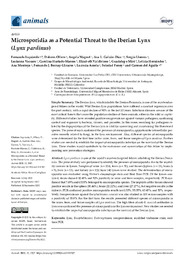Título :
Microsporidia as a Potential Threat to the Iberian Lynx (Lynx pardinus) |
Autor :
Izquerdo, Fernando
Ollero, Dolores
Magnet, Angela 
Galván-Díaz, Ana L.
Llorens, Sergio
Vaccaro, Lucianna
HURTADO MARCOS, CAROLINA 
VALDIVIESO, ELIZABETH 
MIRÓ, GUADALUPE 
Hernández, Leticia
MONTOYA, ANA 
Bornay Llinares, Fernando Jorge 
Acosta Soto, Lucrecia 
Fenoy, Soledad 
Del Águila , Carmen  |
Editor :
MDPI |
Departamento:
Departamentos de la UMH::Agroquímica y Medio Ambiente |
Fecha de publicación:
2020-09 |
URI :
https://hdl.handle.net/11000/30996 |
Resumen :
Lynx pardinus is one of the world’s most endangered felines inhabiting the Iberian Peninsula. The present study was performed to identify the presence of microsporidia due to the mortality increase in lynxes. Samples of urine (n = 124), feces (n = 52), and tissues [spleen (n = 13), brain (n = 9), liver (n = 11), and kidney (n = 10)] from 140 lynxes were studied. The determination of microsporidia was evaluated using Weber’s chromotrope stain and Real Time-PCR. Of the lynxes analyzed, stains showed 10.48% and 50% positivity in urine and feces samples, respectively. PCR confirmed that 7.69% and 65.38% belonged to microsporidia species. The imprints of the tissues showed positive results in the spleen (38.46%), brain (22.22%), and liver (27.27%), but negative results in the kidneys. PCR confirmed positive microsporidia results in 61.53%, 55.55%, 45.45%, and 50%, respectively. Seroprevalence against Encephalitozoon cuniculi was also studied in 138 serum samples with a positivity of 55.8%. For the first time, the results presented different species of microsporidia in the urine, feces, and tissue samples of Lynx pardinus. The high titers of anti-E. cuniculi antibodies in lynx sera confirmed the presence of microsporidia in the lynx environment. New studies are needed to establish the impact of microsporidia infection on the survival of the Iberian lynx.
|
Palabras clave/Materias:
Encephalitozoon
Enterocytozoon
seroprevalence
modified trichrome stain
real-time PCR |
Tipo de documento :
info:eu-repo/semantics/article |
Derechos de acceso:
info:eu-repo/semantics/openAccess
Attribution-NonCommercial-NoDerivatives 4.0 Internacional |
DOI :
https://doi.org/10.3390/ani12192507 |
Aparece en las colecciones:
Artículos Agroquímica y Medio Ambiente
|
 La licencia se describe como: Atribución-NonComercial-NoDerivada 4.0 Internacional.
La licencia se describe como: Atribución-NonComercial-NoDerivada 4.0 Internacional.
.png)
